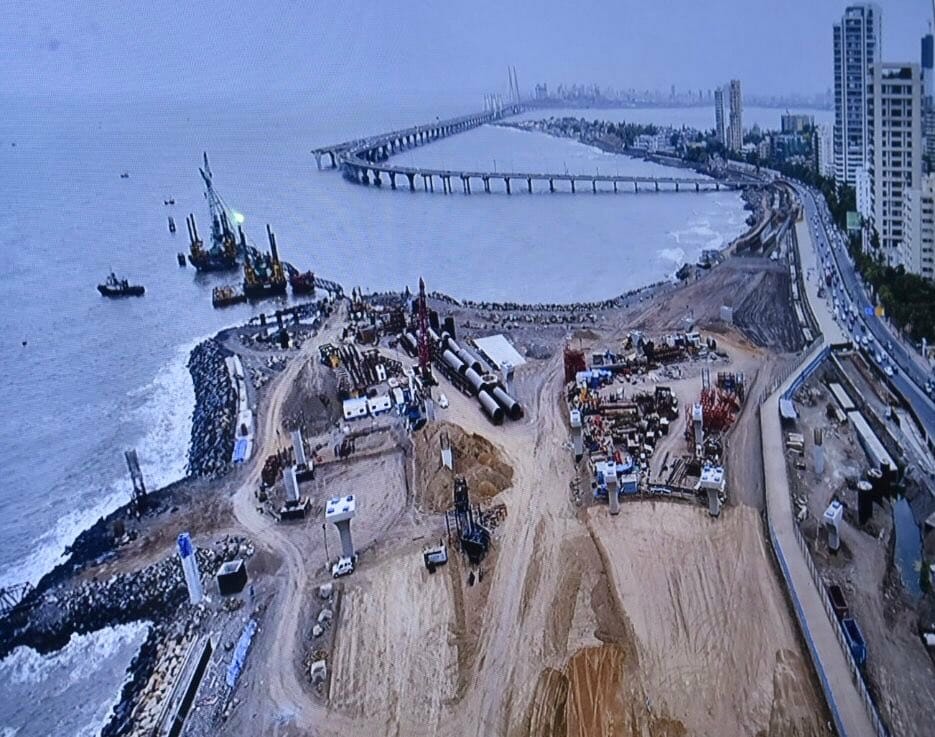The 10.58 km-long coastal road project has faced opposition from environmentalists, urban planners and fisher communities ever since the construction first began in 2018. The road, being built on the promise of effectively reducing city traffic, runs from Princess Street at Marine Drive to the Worli end of the Bandra-Worli Sea Link.
This under-construction part of the project is under the umbrella of the larger plan that stretches up to 29 km and connects Marine Drive to Kandivali. On October 7th, 120 architectural firms under the banner of Mumbai Architect Collective (MAC) wrote a letter to Ashwini Bhide, Additional Municipal Commissioner and in-charge of the project, suggesting changes to the coastal road in order to “save” the coastal city.
The letter, penned by Alan Abraham who is an architect at Abraham John Architects and a member of the MAC, says, “The current design completely disconnects the city from the sea, and while the basic transportation needs of the city are met, they destroy the city’s urban fabric and potentially the amazing waterfront.”
The architects are suggesting the realignment of the coastal road towards the land side rather than the current alignment along the seaside. “This would make everything, from the proposed bus (mass) transit to the open spaces far more accessible and useful,” the letter reads.
Read the full letter here.

Coastal Road Project gets go ahead from top
A total of 111 hectares of land reclamation is required for the project of which 107 hectares have been completed. The project aims to construct an 8-lane road on the outskirts of this land, extending the shore 100m into the sea. The BMC also has plans to use 70 hectares of the reclaimed land to create open spaces like public parks.
The estimated project cost, including contingencies and consultant fees, is Rs 12,950 crores. It has a deadline of November 2023. A part of the project was on halt after the Bombay High Court put a stay on it citing environmental concerns. Earlier this month, the Supreme Court allowed BMC to construct recreational spaces but refused an amusement park, which the BMC had sought in its appeal against the Bombay High Court order.
Environmentalists are against land reclamation for the project primarily because it damages fragile coastal ecosystems. In this letter, the architects have further highlighted that the project would create a visual barrier between the masses and the sea and serve a small percentage of the car-owning population.
Read more: Mumbai’s Coastal Road Project will potentially cause damages: IPCC report
Why BMC is reluctant to makes changes
The authorities claim that more than 60% work has been completed and any change to the project would only lead to an increase in costs, delays and court permissions. While Bhide and chief engineer MM Swami remained unavailable for comment, a former executive engineer on the project Vikas Thombare believes the project is facing criticism from a small minority of people.
“We keep citizens at the forefront and if there is any issue, we address that issue. A lot of studies have been put into the selection of road alignment and experts have approved it,” Thombare says. “We are open to any changes which are feasible for the project in terms of cost and time.”
Thombare didn’t comment on the specifics of the coastal road project as he is no longer involved with it.
‘Arguments have no merit’
Meanwhile, Abraham says the argument put forth by the BMC does not hold merit. “It is they who are increasing the costs and time,” he says. Explaining further, he says many like him have been asking for these changes ever since the construction began. In the last four years, he has met with BMC officials more than a dozen times to convince them to restructure the project.
“I have managed to win a few battles, there has been some realignment at Haji Ali thanks to the changes we proposed, and there were two missing links on the promenade at Worli and at Haji Ali which we have managed to change to achieve a continuous 6.7km long seaside promenade. We are now trying to improve the width of the promenade,” he says.
In his letter, Abraham says that it is unlikely that court permissions would be required for the realignment of the road. However, he does provide in the letter an alternative solution where more open space is achieved even if the road alignment remains unchanged.
Reduce the road median from 11m to 1m, the letter suggests. “As a result, the promenade now increases from 20m to 30m. This is a 50% increase along the entire 6.7km long seafront. Also, as a result, the road width, and therefore pedestrian crossings now reduce from 45m to 35m. This would be a major saving in cost.”
Projects are headed by bureaucrats
The coastal road project received a major push from the earlier Uddhav Thackeray-led Maharashtra Vikas Aghadi government despite backlash from various quarters. “It has been a pet project of every government, there’s no political party that has opposed either the whole project or a part of the project,” Abraham says.
The change in the government has not brought about any significant change in the overall approach of the authorities as the project is largely bureaucrat-run, he says.
“Their (the bureaucrats’) job is to provide a road, and they have succeeded. But what does it do? We need better roads within the city, not outside in the sea,” Abraham says.
He adds that the project is largely contractor-driven and architects were not consulted in the first phase. There needs to be more focus on design, he says. “It is not a complicated project, it is just a road at the end of it.”